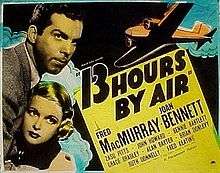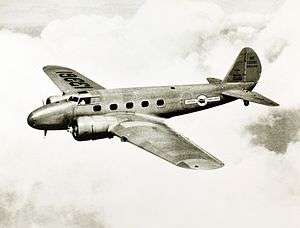13 Hours by Air
13 Hours by Air (also known as 20 Hours by Air) is a 1936 drama film made by Paramount Pictures and directed by Mitchell Leisen. The film stars Fred MacMurray and Joan Bennett. The screenplay was written by Kenyon Nicholson and Bogart Rogers, based on story Wild Wings by Bogart Rogers and Frank Mitchell Dazey. 13 Hours by Air was also the forerunner of the disaster film, a genre featuring a complex, heavily character-driven ensemble cast film, exploring the personal dramas and interactions that develop among the passengers and crew as they deal with a deadly onboard emergency.
| 13 Hours by Air | |
|---|---|
 Theatrical poster | |
| Directed by | Mitchell Leisen |
| Produced by | E. Lloyd Sheldon |
| Written by | Kenyon Nicholson Bogart Rogers |
| Based on | Wild Wings by Bogart Rogers, Frank Mitchell Dazey |
| Starring | Fred MacMurray Joan Bennett |
| Music by | Heinz Roemheld (composer) Irvin Talbot (conductor) |
| Cinematography | Theodor Sparkuhl |
| Edited by | Doane Harrison |
Production company | |
| Distributed by | Paramount Pictures |
Release date |
|
Running time | 77 minutes |
| Country | United States |
| Language | English |
Plot
Airline pilot Jack Gordon (Fred MacMurray) on a flight from New York to San Francisco, is immediately attracted to beautiful passenger Felice Rollins (Joan Bennett). Known as a "lady's man", he bets stewardess Vi Johnson (Ruth Donnelly) that he will take Felice out to dinner that evening. A jewel robbery is in the news and a beautiful blonde is implicated, with Jack suspecting that Felice may be the culprit. On a stop over in Chicago, Jack learns instead that his passenger is a wealthy socialite at odds with another passenger, Count Stephani (Fred Keating). Jack worries that he may have a crisis involving the Count when he finds Stephani has a gun aboard. Other passengers include Dr. Evarts (Brian Donlevy) and Curtis Palmer (Alan Baxter), both of whom seem to be harboring a secret.
Felice is trying to get to San Francisco in order to prevent her sister from marrying the Count's brother, but the flight runs into bad weather. Jack and Freddie Scott (John Howard), his co-pilot, are persuaded to fly on, but are eventually forced to make an emergency landing. Dr. Evarts tells Jack he is a federal agent pursuing Palmer, a notorious criminal. Palmer shoots Freddie and Dr. Everts and hijacks the aircraft. Jack manages to overcome Palmer, and with the help of Felice, is able to take off and fly to San Francisco. When the flight lands, he is able to have his dinner with Felice, collecting his bet, knowing that he will need the money for a marriage licence.
Cast
|
|
Production

Under the working title of 20 Hours by Air, the production changed its name to more closely approximate the actual flying time to fly cross-country in the United States, based on the recent exploits of pilots such as Wiley Post. Filmed at the Alhambra Airport, California, in Cleveland, Ohio, and Beaver Dam, Wisconsin, using United Air Lines Boeing 247 airliners. Second unit filming involved a flight from Newark to Los Angeles to obtain actual footage to be used in the film. An aircraft assigned to the production was also involved in a minor accident.[1]
The pairing of MacMurray and Bennett brought together two dependable leads who worked as Paramount Studios contract players. They were sometimes loaned out to other concerns, but steadily climbed up from films such as 13 Hours by Air to more prestigious fare.[2]
Reception
Film reviewer Frank S. Nugent, in his review for The New York Times, called 13 Hours by Air "pleasant". "... there is no disputing the liveliness of the melodrama. The device of tossing a miscellany of humans and motives together on a bus, plane, train or airliner and letting them work out their destiny is as formular as the Bartender's Guide and has been used as often, but Bogart Rogers's and Frank Mitchell Dazey's story has been screened with a shrewd sense of pace, with a purposeful preservation of suspense and a knack for comic interlude."[3]
13 Hours by Air is one of over 700 Paramount Productions, filmed between 1929 and 1949, which were sold to MCA/Universal in 1958. The Paramount catalogue was destined for television distribution, and have been owned and controlled by Universal ever since.
References
Notes
- "Notes: 13 Hours by Air". Tunrer Classic Movies. Retrieved: December 14, 2014.
- Maltin 1994, pp. 67, 544–555.
- Nugent, Frank S. "' 13 Hours by Air,' a Transcontinental Melodrama." The New York Times, April 30, 1936.
Bibliography
- Maltin, Leonard. Leonard Maltin's Movie Encyclopedia. New York: Dutton, 1994. ISBN 0-525-93635-1.